Tag Archive: Multimodal
April 26, 2017
by Carole Zangari -
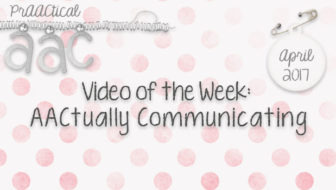
At school In clinics and hospitals At home In restaurants and shops People are supporting children with complex communication needs by speaking AAC and building opportunities for communication learning. Here are a few short videos showing what they’ve been up to. Vanderbilt’s Early Intervention Program are getting some communication in while playing and making music in preschool. Check out Shelane Nielsen and her handsome guy gooping it up in AACtion at home. Jill Baldessari explains how Miguel and his SLP get their eye gaze on. Take a peek at Deb using both prestored messages and single word vocabulary at a restaurant. Let’s see how these classmates are working together in their general education classroom. Ready for a bit of reading instruction, AAC style? Do you have videos of AACtual communication? We’d love to have you share them!
Filed under: Video of the Week
Tagged With: communication, Multimodal, video
May 6, 2015
by Carole Zangari -
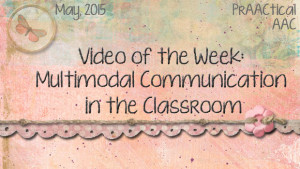
All around the world, students with AAC needs are increasingly afforded the tools and supports that they need to build effective communication skills. Today, we travel to England to peek into a classroom at the Milestone School in Gloucestershire. One thing that I just love about this video is that the adults honor and model multiple modes of communication. AAC devices are wonderful, but we can’t get so focused on them that we forget the important role that gestures, vocalizations and manual signs can play. Take a look. Direct Link to Video: https://www.youtube.com/watch?v=HygplCyZtoA
Filed under: Video of the Week
Tagged With: classroom, manual signs, Multimodal, schools
October 3, 2014
by Carole Zangari -
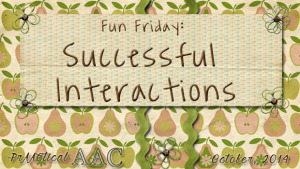
Friday is a great day to pause for a bit of fun. I had the opportunity to meet Janelle Sampson, of Two Way Street, this spring and learn a little bit about the work that she does. In this post, we share a video of one of her little friends using various modalities to communicate with his mother and brother. Enjoy this wonderfully prAACtical interaction! Big Words for Little Boys: https://www.youtube.com/watch?v=5FWimeCvbIY
Filed under: PrAACtical Thinking
Tagged With: Fun Friday, interaction, Multimodal, vocabulary
June 7, 2013
by Carole Zangari -
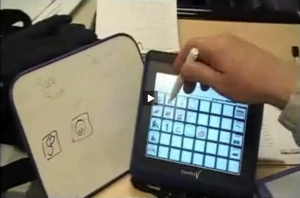
Adults use multiple modes of communication, too. This video from the Dynavox Implementation ToolKit gives us some great examples of adults using varied strategies for communication.
Filed under: Video of the Week
Tagged With: adults, modes of communication, Multimodal, SGD
April 22, 2012
by Carole Zangari -
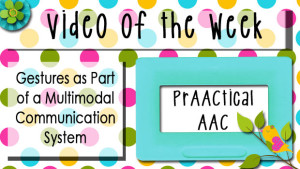
Gesture Recognition in Aphasia Therapy (GeST) is a project that emphasizes the use of gestures to help individuals with aphasia communicate effectively. GeST is a computer-based program to teach simple gestures and provide home practice opportunities. Project leaders used a participatory design to gain the input from 5 people with aphasia in developing the program. They are currently evaluating its effectiveness in a pilot study. We are big fans of multimodal communication and love the prAACtical applications of this program. You can check it out for yourself at this video.
Filed under: Video of the Week
Tagged With: aphasia, computer, Multimodal, research
February 4, 2012
by Carole Zangari -
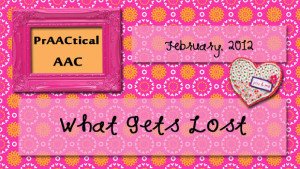
Imagine having one key communication strategy and no one knew that it existed. This horrifying experience was documented in the book ‘I Raise My Eyes to Say Yes,’ the autobiography of Ruth Sienkiewicz-Mercer. For years, she effectively used eye gaze with her family to answer yes/no questions, but when Ruth was placed at a residential facility, things eventually changed. Staff turnover, something we’re all familiar with, was the culprit. With time, new staff came in and didn’t realize that Ruth communicated with her eyes. Ruth was silenced for years until someone noticed that her ‘eyes up’ movement wasn’t reflexive or random. She was talking, but no one was listening. — While this was an extreme example, most AAC practitioners can recount their own stories of people whose AAC messages weren’t effectively translated once they moved to new settings. The transition to a new environment, where untrained partners may fail to recognize... [Read More...]
Filed under: PrAACtical Thinking, Strategy of the Month
Tagged With: AAC system, collaboration, Multimodal, visual literacy
January 20, 2012
by Carole Zangari -
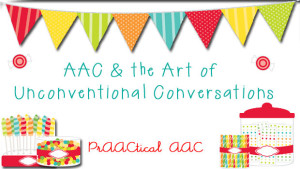
There’s an art to having a conversation with someone who has significant communication challenges. One of my favorite experiences with this dates back to the 1980’s, when I was working with a preschooler who had Rett Syndrome. Julia was a beautiful little girl who lived with her (very young) mom and her grandma. Grandma watched Julia while mom was in school, and I spent a good amount of time visiting them in their modest home (a trailer) trying to earn their trust and figure out how to help Julia communicate better in school. – At home, as it turns out, she was communicating just fine, at least for the very basic things. A typical conversation between Julia and her grandma went like this. Julia paces around the coffee table, wringing her hands, rocking a bit, and staring at the carpet. She pauses in front of the TV and Grandma says... [Read More...]
Filed under: PrAACtical Thinking, Strategy of the Month
Tagged With: communicative acts, Conversations, Multimodal
January 14, 2012
by Carole Zangari -
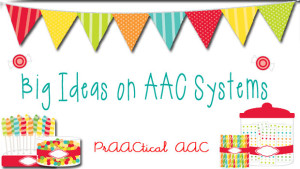
I had some great conversations with families this month about AAC and how to effectively translate strategies from therapy and school to a home environment. Although their children were all different ages, had various disabilities, and used a diverse set of AAC tools, there were a couple of common elements in those conversations.One thing that played a central role was this question: What IS an AAC system? We all know the textbook definition of AAC and that it refers to a set of tools, techniques, and strategies used to enhance the communication of people with significant language difficulties. We know that AAC is often subdivided into unaided communication (including gestures, signs, movement, vocalization, etc) and aided communication (such as communication books, speech generating devices [SGDs], and choice boards).But the general case is only helpful if you’re in AAC class or studying for the PRAXIS. In clinical practice, we need to... [Read More...]
Filed under: Strategy of the Month
Tagged With: AAC system, intervention, modes of communication, Multimodal, SGD
January 8, 2012
by Carole Zangari -
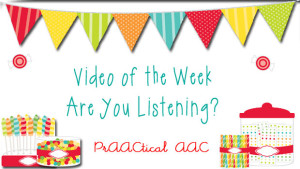
Multimodal communicators don’t get much cuter than this! Direct Link to Video: https://www.youtube.com/watch?v=mlp0R3NxaxU
Filed under: Video of the Week
Tagged With: Multimodal








